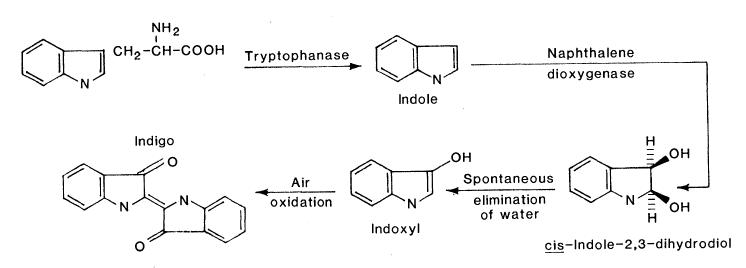Biosynthesis of Indigo
When the Nah7 operon is transformed into E. coli and expressed, the cells have the ability to produce indigo from tryptophan. Therefore, as an indirect proof of the Nah operon's function, several cultures were set up to determine if indigo was present when supplemented with 200 μM tryptophan. After one night of initial testing, the cells did not appear to have been expressing the operon strongly enough for red fluorescent protein, which it was labeled with, to be detectable. After two nights, the red fluorescent protein could be seen, but an extraction with diethyl ether did not appear to remove any hydrophobic purple dye from the cultures, nor were purple spots visible on the plate.
DEFINATELY
MAYBE ADD SOMETHING HERE
 Fig. 1. Pathway by which E. coli can produce indigo from tryptophan when expressing genes of the Nah7 operon. (Ensley et al., 1983)
Fig. 1. Pathway by which E. coli can produce indigo from tryptophan when expressing genes of the Nah7 operon. (Ensley et al., 1983)
References
Ensley, B., Ratzkin, B., Osslund, T., Simon, M., Wackett, L., & Gibson, D. (1983). Expression of naphthalene oxidation genes in Escherichia coli results in the biosynthesis of indigo. Science, 222(4620), 167-9.


 Fig. 1. Pathway by which E. coli can produce indigo from tryptophan when expressing genes of the Nah7 operon. (Ensley et al., 1983)
Fig. 1. Pathway by which E. coli can produce indigo from tryptophan when expressing genes of the Nah7 operon. (Ensley et al., 1983)
 "
"







